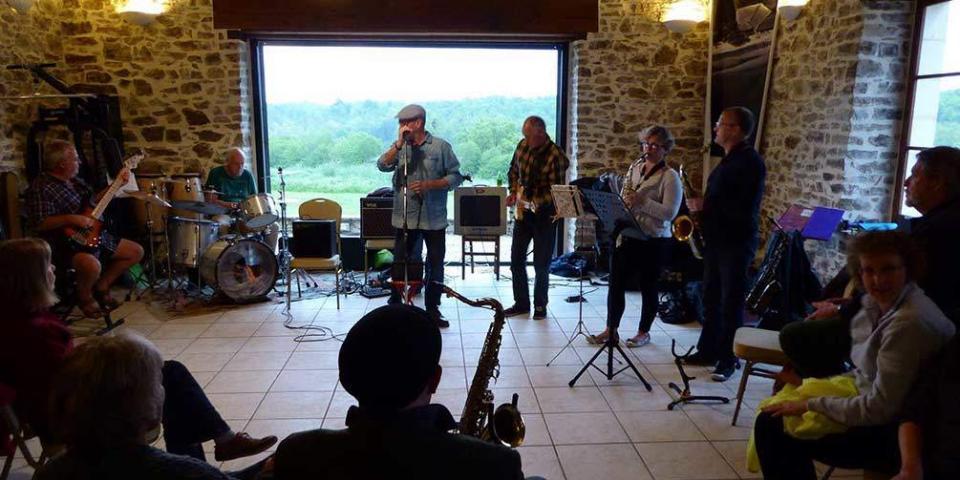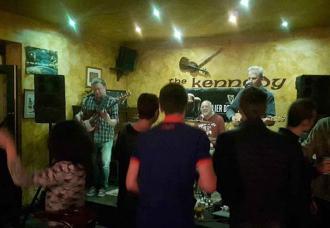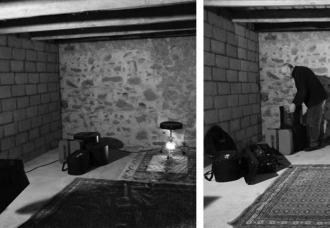Big Band Jazz. Part 2 — Reading Music
As I talk about my experience with a Big Band I can’t help but also talk about consciousness and the art of learning. I’m trusting that you DON’T need to be a drummer or musician to enjoy this article – but we’ll see.
Up until just over a year ago my only experience of a Big Band (apart from seeing Buddy Rich live and listening to the occasional tune played on the radio or television) was sitting in with a rehearsal band close to the old market town, and birthplace of the Bard, Stratford-upon-Avon. I didn’t read any music for this but kept a steady swung beat for the other musicians to play along with. They seemed very happy and perhaps their regular drummer didn’t swing quite as well – but that’s supposition. Now we fast forward about thirty years and through a series of unlikely events I got a phone call out of the blue.
My reputation must have preceded me as I got a call from a musician down south from me in the Dordogne, asking if I wanted to play on a jazz course…well, you bet I did. Would I ring ‘so-and-so’ (a lovely lady it turned out) in the UK and discuss such. You bet I would! Now I had been playing more mainstream and trad jazz in the south-west of England for a few years and had even drummed (and played flute) on a jazz course…and I’d played with other jazz outfits from time to time. Also – here in France – I played with a jazz quintet and was in the ‘house band’ for a regular jazz ‘n’ Blues session (more blues than jazz mind). I was confident.
The lady I spoke with was charming and it was she that organised the course in question…but there was just one thing…after I’d pretty well agreed to drum for her on the course, she told me it was with a Big Band. Now that was something different and playing – for real – with a Big Band is something different too – I knew that much!
What makes a Big Band different? Well one of its early names was a ‘reading band’. You are expected to have music put in front of you and play it. Well, naturally, you might think…but most drummers either don’t read or they read the various styles of ‘usual’ drum music. Big Band charts are a different kettle of fish – so to speak. Drummers normally read variations of rhythms adapted for the drum-kit only. The drum-kit consisting of the snare drum, the bass (or kick) drum, the tom-toms and the various cymbals. Each piece of the kit is allocated a conventional style note or a note with a cross (or similar) if for a cymbal. It’s a matter of looking and hitting one, or up to four notes, in succession. We have four limbs! But a Big Band chart is about playing with a huge horn section whereby we need to accompany and highlight their notes. Imagine:
1/ If I play a very SHORT note on the snare drum (marching drum) the sound might be like: bu
2/ If I play a very LONG note on the snare drum the sound might also be a bu.
3/ There are only TWO ways to sustain a note/sound on the drum kit, either: A roll (on the drum or cymbal) or a cymbal strike/crash.
4/ Thus when reading drum music it is often about the relationship with the next note:
Bu…………………………………HIT
Bu..HIT
(The dots represent silence.)
Of course the distance between one note and the next is dependent on the note being struck such as:
Minim (Half Note – two notes in a bar of 4/4))
Crotchet (Quarter note – four notes in a bar of 4/4)
Quaver (Eighth note – eight notes in a bar of 4/4)
Semi-Quaver (Sixteenth-note – sixteen notes in a bar of 4/4) etc.
So sound duration on the drums comes from a roll (like in a marching band or on a tympani) or on a cymbal crash or roll where the sound continues. But when we read most drum music it’s all a Bu – not a Baaaaaaaaaaaaaaaaaaaaaaaaaaaaaa!
This becomes especially important in Big Band music. As I have said, we are often phrasing along with the saxes/trumpets/trombones and when these instruments play their notes they are often tied (and thus syncopated) notes. Say something like: BaaaBaaaaaaaaaBaaBu or with spaces (rests): Baaa….Baaa….Bu.Bu.Baaaaaaaaaaaa . If you say this you’ll get an idea, then imagine a big brass section blasting out the notes. Of course the brass plays pitched notes and the drums are un-pitched (pitched percussion includes: tympani/vibes/glockenspiel/tubular bells).
Therefore – as a drummer in a Big Band we are presented with a ‘chart’. This chart has all the usual components of music: bars/bar-lines/time-signatures/style/tempo/repeat-marks/Coda etc. And regular notes. The charts tend to be under-written or over-written (too complicated) but we as drummers are meant to look, read, interpret and add taste and style to whatever is written. Okay, this might be getting a bit confusing so back to my first experience.
The Big Band course I attended as the drummer took place in a beautiful part of France. Just a pleasure to drive there…rolling countryside, woods, mostly empty roads and the weather good. I really didn’t know what to expect and was quite nervous. Before I set off I had spent a couple of weeks trying to familiarise myself with the various styles of Big Band drummers. Also I had been sent some of the tunes we were likely to play. Having printed the drum charts I searched and found various Big Band interpretations on youtube. The problem was that there was NEVER an exact copy it seemed…I did finally find a few tunes that resembled what I had printed and there was a superb version of Buddy Rich (and his band) playing ‘In a Mellow Tone’. This helped give me some idea of how a drummer was interpreting the drum parts similar to mine. This was all very useful but also quite frustrating. Even if I found the same tune played by a number of different bands – the drummer was playing quite different ‘chops’ (style/method of playing).
On the day before I was to leave I found a version of a slow funk number that one of the smaller ensembles (as it turned out) was going to play. I recorded myself on an old 80s cassette recorder as I hadn’t set up my studio. I couldn’t quite get it right…so I became rather obsessive. Eventually I ‘got it down’ and this gave me some small sense of confidence.
On arrival I was greeted enthusiastically by some of the other musicians who had already arrived. All of the musicians on the course flew in or drove over from England. Their excitement at meeting me was daunting. As best I could I explained that I wasn’t, in fact, a Big Band drummer – as such. My attempts at deflating their ardour was waved aside dismissively. They’d heard such great things about me. Their anticipation made my nervousness increase somewhat.
The place itself comprised a number of buildings – all beautifully renovated. I was staying in the old farmhouse and was shown over the complete site. It really was (is!) impressive. The Big Band was to be housed in the ‘Games Room’ – large enough to seat twenty plus musicians and their instruments including piano and my drum-kit. Behind me there was an end wall almost totally taken by a window with views over the fields. We ate in a converted granary (or barn) – tables laid end to end enough to seat all the musicians and any family members. There would be a rota for each day with a team taking care of breakfast/lunch and dinner. I was with the vegetarians – and as I said I could cook a good vegetable curry I was immediately promoted to Head Chef! I hadn’t cooked for anyone for about twenty years (my wife is an accomplished cook). That was an additional anxiety. That night I tried to read as much of the music I had brought with me as possible. The following morning was the actual start of the course. Everyone had asked about me at dinner – and I’d done my best to moderate expectations. Perhaps not the best way to conduct myself – but I was NOT a Big Band drummer.
The morning came – breakfast went…I was probably the first in the rehearsal room and installed myself behind my kit. There is a real frisson about the sound of many musicians tuning and warming up. There was indeed an air of expectancy.
The crunch!
The chap running the band is a renowned musician – his main instrument being the sax. In fact I only presume he plays piano too, at least – but having heard him do the following one can only be impressed (musicians, singers especially could try this):
Take the root note of a scale and sing it up and down (using do re mi)…then keeping the same tonality move to the next note – one semi-tone above – and use that as the ‘do’ note and sing up and down the scale from there. This would be like singing from C on the piano up through the white notes then moving to C# and singing from there. C# major has seven sharps! This is some task – then repeat through all the previous chromatic steps in the minor keys. Attention: each note must keep its relative tonality. The C remains the C and the C# remains the C#! This is the difficulty.
As many of the musicians were returners it was announced that we would start with a tune all were familiar with. More pressure. Okay let’s play….I turned to the music folder I had been given and flicked through till I had the relevant piece. In the few seconds I had, I had to identify the overall structure:
Was there a Coda (- DS Al CODA where we have to jump back to a sign – like a stylised S – and then go on to the Coda – an ending – where marked…thus stopping unnecessary repetition)?
Were their repeat bars (where a phrase is repeated by having double bar-lines and dots)?
Was there a style of music indicated and/or tempo?
Then it was a question of looking at the opening bars for anything ‘unusual’ – tacit bars or fills (where we get to play solo or at least phrasing round the drums with the rest, or part of, the band).
Okay – sticks clutched but trying to relax.
We were counted in and then the ‘education’ began. How this education worked was something like:
HEARING – READING – PLAYING
PLAYING – HEARING – READING
Looping of consciousness if you will. Becoming:
HEARING – READING – PLAYING – COMPREHENDING (understanding the music and how that corresponded to what was being played). Thus: learning what to play at the same time as listening at the same time as continual adaption of what I was playing. Obviously this skill unfolded gradually and – as ever – the more we played the better I got at it. Not to say there weren’t some ‘hairy’ moments!
It was interesting how I was reducing the gap between reading and playing and/or listening and playing – so that eventually I could ‘lead’ the band.
The equivalent to this would be if you had a reasonable grasp of a second language (you could converse well) but were then told you had to debate upon a technical subject – containing words/ideas truly foreign to you!
At the micro level (if you will) – I was reading the music – as stated above – with one eye on what was coming and obviously counting bars. Making quick decisions…making sure I played repeats – making sure I was at the right place (there are often capital letters marked on the music that indicates some kind of change of feel; these are great for marking oneself at the right place or needing to skip forward or backwards). As a drummer we also get a sense of ‘feel’ for four/eight/sixteen bar measures – the way the music is laid out on the chart helps too…either, say, eight bars each line or if there’s something unusual going on a different length that corresponds with the differing phrasing.
Regarding this first session of the Big Band – I can say that it and the small ensembles I played with went so much better than I expected; on top of that I cooked a vegetable curry for 20+ people (with help) and that went down well…I also jammed with a group who arrived (with the bassist who had recommended me) as entertainment on one of the nights. And more to the point I was asked back!
I’m going to keep this last part, the conclusion if you will, fairly short:
Before the second session (earlier this year – an Early Easter) I went through the parts I had printed out at the end of the last session. I also invested in some Big Band books: ‘Drummer’s Guide To Big Band’ – Garey Williams and ‘Big Band Drumming At First Sight’ – Steve Fidyk. What I learnt from these in the brief time I had to study them was the ‘set up’ – whereby the drummer anticipates a phrased horn part with a fill into it. Say the horn part is: Baaaa baaaa ba ba. The drummer needs to fill into that very beginning sound – such as: Tata tata ta ta tata tatata – Baaaa baaaa ba ba (and also getting behind these horn notes in the most musical way possible). The articulation on the drum-kit must mirror the length and intensity of the notes played. There’s a LOT that has to go on in the drummer’s head – and then be transferred through his four limbs.
As there was a professional female vocalist coming to this particular Big Band course I concentrated on some of the vocal numbers we might be likely to play. To a certain degree that bit of homework paid off.
This last course was great…and I bedded down in the rehearsal room with all the instruments. I wasn’t in full health (there had been a nasty chest bug going round) but I coped fine – I trust. The whole week went well with some tricky numbers (in particular: ‘Chameleon’ – Herbie Hancock/Bennie Maupin/Paul Jackson and Harvey Mason). But there was one incident that was somewhat shocking when the caretaker of the estate had a heart-attack! An air ambulance was called and he was taken to the nearest hospital (the last I heard he was doing fine). Luckily we had an ex-doctor as one of our musicians who was able – at least – to comfort/reassure him.
Every evening, after eating, we would play at a kind of ‘Jazz Cafe’ – an informal get together playing stuff we’d gone through in the day and maybe some impromptu numbers. That was great fun too! But the main thing for me was having the chance to play IN and WITH a Big Band and to talk with fellow musicians impassioned by their art. All being well I’ll be there again next year…
If you have ANY questions regarding drumming, reading & playing music, and/or playing jazz in a big band, please feel free to ask.
Leave a reply
Log in using below social networks to join the discussionThis is a test








